Change Management Report
VerifiedAdded on 2020/01/28
|11
|3482
|74
Report
AI Summary
This report critically analyzes the change management strategies at Babcock Rail, focusing on driving factors for change, stakeholder tensions, and recommendations for fostering a positive organizational culture. It includes a detailed examination of the 'Fit for the Future' initiative and its alignment with change management models, providing insights into effective project management and stakeholder engagement.
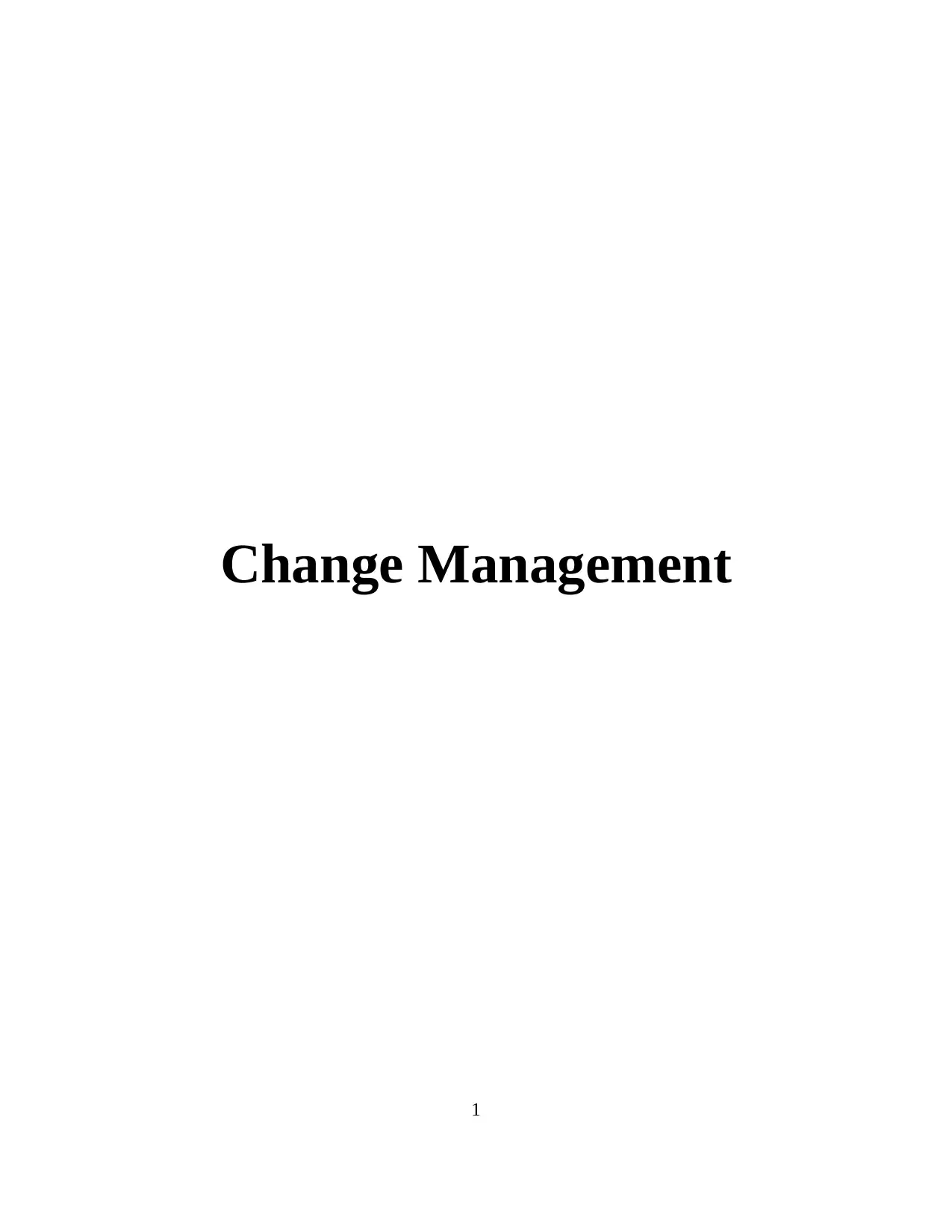
Change Management
1
1
Paraphrase This Document
Need a fresh take? Get an instant paraphrase of this document with our AI Paraphraser
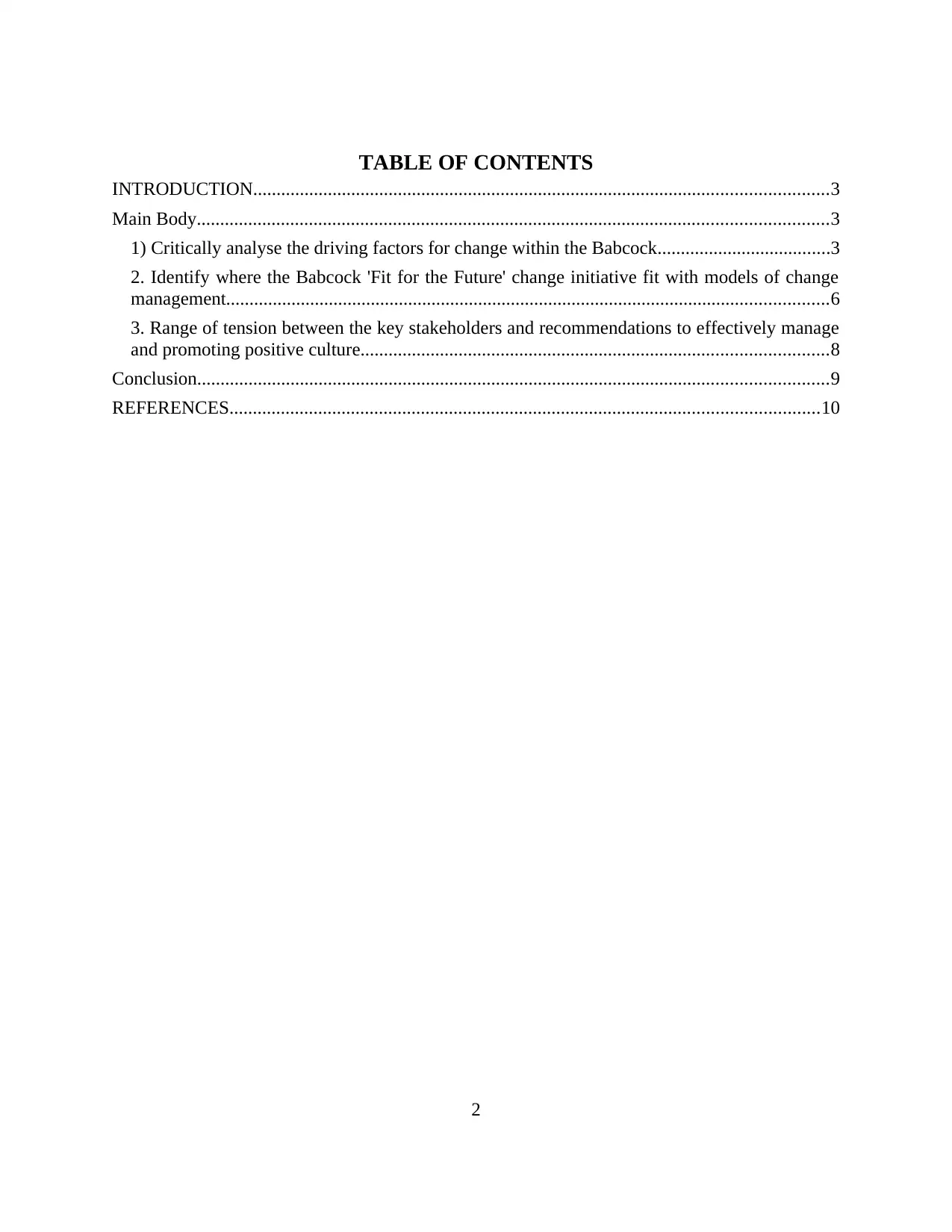
TABLE OF CONTENTS
INTRODUCTION...........................................................................................................................3
Main Body.......................................................................................................................................3
1) Critically analyse the driving factors for change within the Babcock.....................................3
2. Identify where the Babcock 'Fit for the Future' change initiative fit with models of change
management.................................................................................................................................6
3. Range of tension between the key stakeholders and recommendations to effectively manage
and promoting positive culture....................................................................................................8
Conclusion.......................................................................................................................................9
REFERENCES..............................................................................................................................10
2
INTRODUCTION...........................................................................................................................3
Main Body.......................................................................................................................................3
1) Critically analyse the driving factors for change within the Babcock.....................................3
2. Identify where the Babcock 'Fit for the Future' change initiative fit with models of change
management.................................................................................................................................6
3. Range of tension between the key stakeholders and recommendations to effectively manage
and promoting positive culture....................................................................................................8
Conclusion.......................................................................................................................................9
REFERENCES..............................................................................................................................10
2
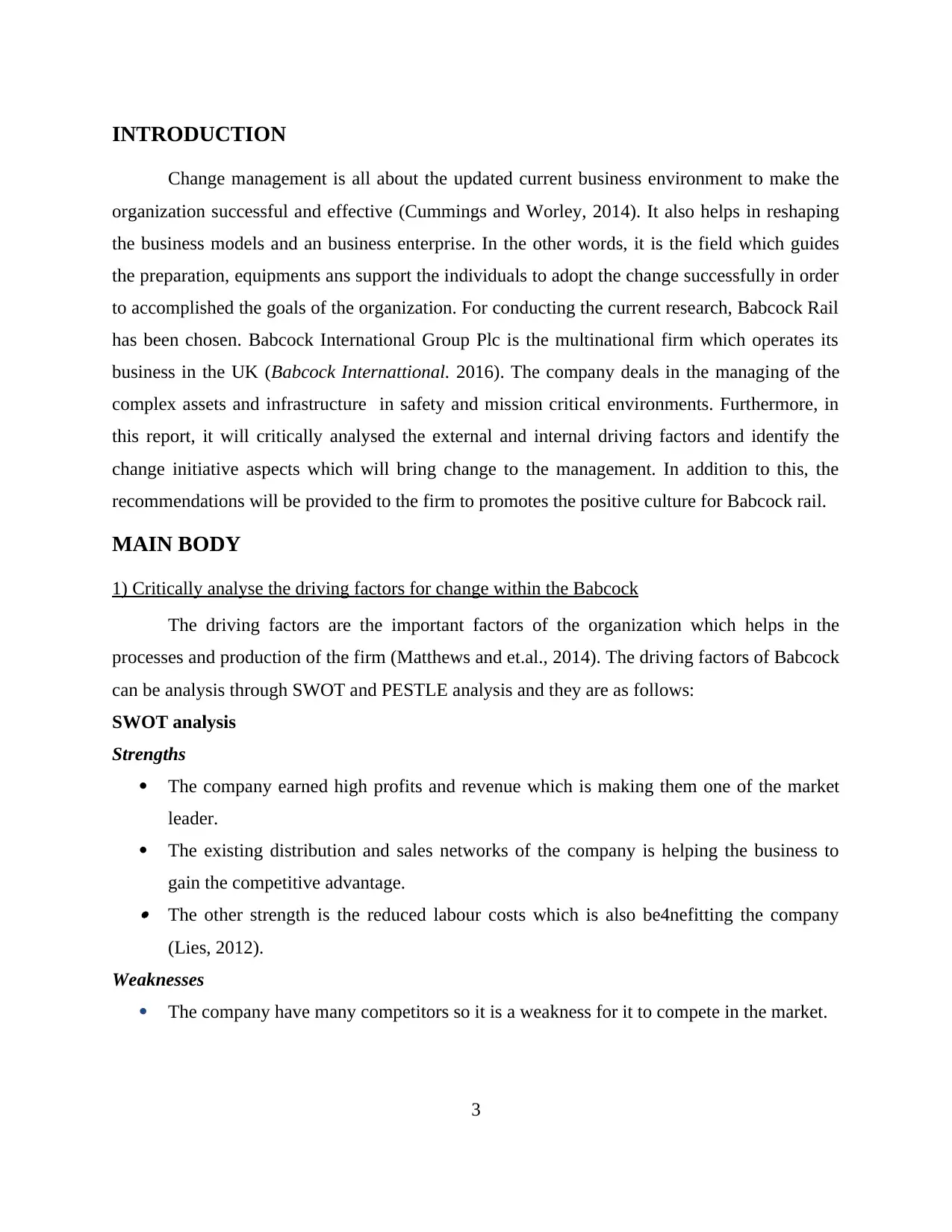
INTRODUCTION
Change management is all about the updated current business environment to make the
organization successful and effective (Cummings and Worley, 2014). It also helps in reshaping
the business models and an business enterprise. In the other words, it is the field which guides
the preparation, equipments ans support the individuals to adopt the change successfully in order
to accomplished the goals of the organization. For conducting the current research, Babcock Rail
has been chosen. Babcock International Group Plc is the multinational firm which operates its
business in the UK (Babcock Internattional. 2016). The company deals in the managing of the
complex assets and infrastructure in safety and mission critical environments. Furthermore, in
this report, it will critically analysed the external and internal driving factors and identify the
change initiative aspects which will bring change to the management. In addition to this, the
recommendations will be provided to the firm to promotes the positive culture for Babcock rail.
MAIN BODY
1) Critically analyse the driving factors for change within the Babcock
The driving factors are the important factors of the organization which helps in the
processes and production of the firm (Matthews and et.al., 2014). The driving factors of Babcock
can be analysis through SWOT and PESTLE analysis and they are as follows:
SWOT analysis
Strengths
The company earned high profits and revenue which is making them one of the market
leader.
The existing distribution and sales networks of the company is helping the business to
gain the competitive advantage. The other strength is the reduced labour costs which is also be4nefitting the company
(Lies, 2012).
Weaknesses
The company have many competitors so it is a weakness for it to compete in the market.
3
Change management is all about the updated current business environment to make the
organization successful and effective (Cummings and Worley, 2014). It also helps in reshaping
the business models and an business enterprise. In the other words, it is the field which guides
the preparation, equipments ans support the individuals to adopt the change successfully in order
to accomplished the goals of the organization. For conducting the current research, Babcock Rail
has been chosen. Babcock International Group Plc is the multinational firm which operates its
business in the UK (Babcock Internattional. 2016). The company deals in the managing of the
complex assets and infrastructure in safety and mission critical environments. Furthermore, in
this report, it will critically analysed the external and internal driving factors and identify the
change initiative aspects which will bring change to the management. In addition to this, the
recommendations will be provided to the firm to promotes the positive culture for Babcock rail.
MAIN BODY
1) Critically analyse the driving factors for change within the Babcock
The driving factors are the important factors of the organization which helps in the
processes and production of the firm (Matthews and et.al., 2014). The driving factors of Babcock
can be analysis through SWOT and PESTLE analysis and they are as follows:
SWOT analysis
Strengths
The company earned high profits and revenue which is making them one of the market
leader.
The existing distribution and sales networks of the company is helping the business to
gain the competitive advantage. The other strength is the reduced labour costs which is also be4nefitting the company
(Lies, 2012).
Weaknesses
The company have many competitors so it is a weakness for it to compete in the market.
3
⊘ This is a preview!⊘
Do you want full access?
Subscribe today to unlock all pages.

Trusted by 1+ million students worldwide
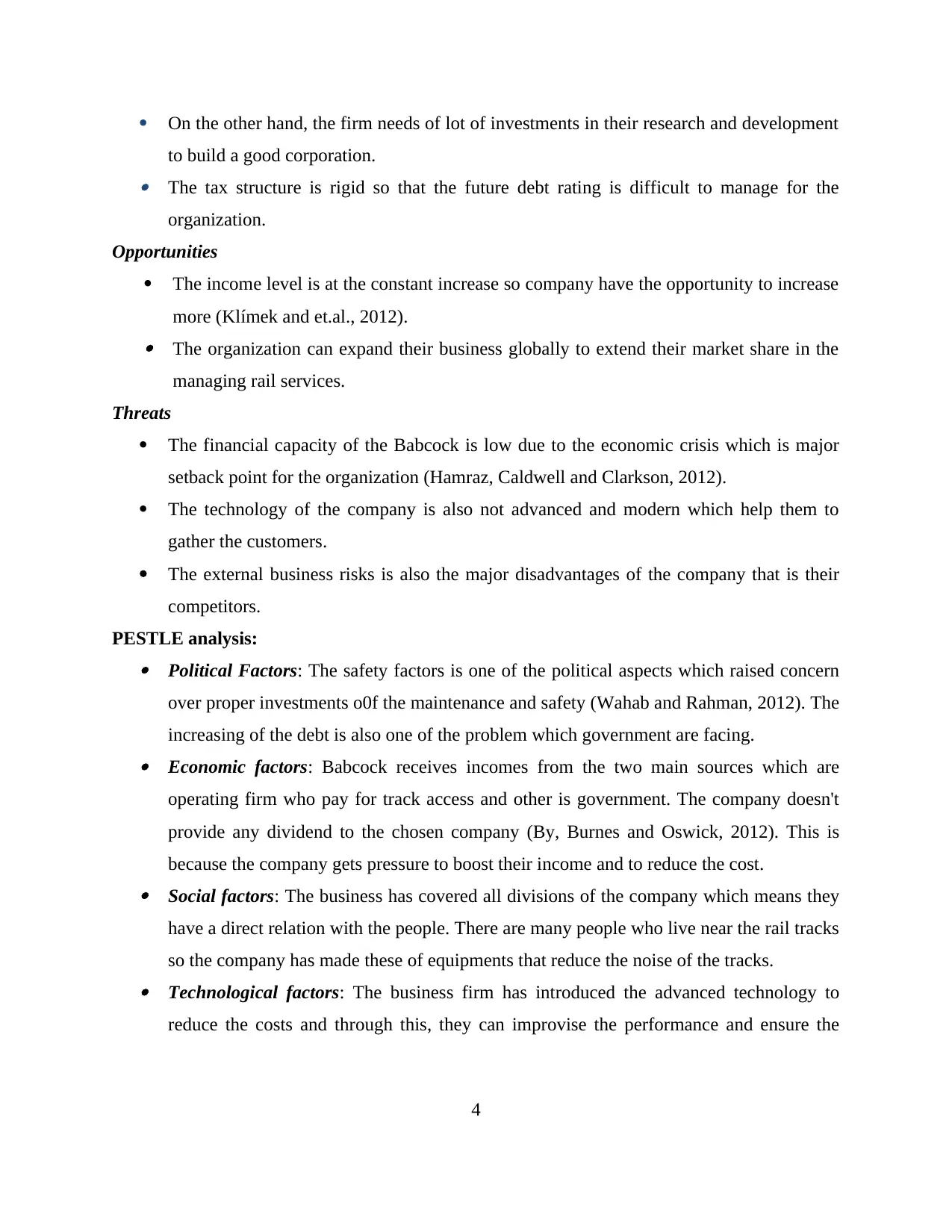
On the other hand, the firm needs of lot of investments in their research and development
to build a good corporation. The tax structure is rigid so that the future debt rating is difficult to manage for the
organization.
Opportunities
The income level is at the constant increase so company have the opportunity to increase
more (Klímek and et.al., 2012). The organization can expand their business globally to extend their market share in the
managing rail services.
Threats
The financial capacity of the Babcock is low due to the economic crisis which is major
setback point for the organization (Hamraz, Caldwell and Clarkson, 2012).
The technology of the company is also not advanced and modern which help them to
gather the customers.
The external business risks is also the major disadvantages of the company that is their
competitors.
PESTLE analysis: Political Factors: The safety factors is one of the political aspects which raised concern
over proper investments o0f the maintenance and safety (Wahab and Rahman, 2012). The
increasing of the debt is also one of the problem which government are facing. Economic factors: Babcock receives incomes from the two main sources which are
operating firm who pay for track access and other is government. The company doesn't
provide any dividend to the chosen company (By, Burnes and Oswick, 2012). This is
because the company gets pressure to boost their income and to reduce the cost. Social factors: The business has covered all divisions of the company which means they
have a direct relation with the people. There are many people who live near the rail tracks
so the company has made these of equipments that reduce the noise of the tracks. Technological factors: The business firm has introduced the advanced technology to
reduce the costs and through this, they can improvise the performance and ensure the
4
to build a good corporation. The tax structure is rigid so that the future debt rating is difficult to manage for the
organization.
Opportunities
The income level is at the constant increase so company have the opportunity to increase
more (Klímek and et.al., 2012). The organization can expand their business globally to extend their market share in the
managing rail services.
Threats
The financial capacity of the Babcock is low due to the economic crisis which is major
setback point for the organization (Hamraz, Caldwell and Clarkson, 2012).
The technology of the company is also not advanced and modern which help them to
gather the customers.
The external business risks is also the major disadvantages of the company that is their
competitors.
PESTLE analysis: Political Factors: The safety factors is one of the political aspects which raised concern
over proper investments o0f the maintenance and safety (Wahab and Rahman, 2012). The
increasing of the debt is also one of the problem which government are facing. Economic factors: Babcock receives incomes from the two main sources which are
operating firm who pay for track access and other is government. The company doesn't
provide any dividend to the chosen company (By, Burnes and Oswick, 2012). This is
because the company gets pressure to boost their income and to reduce the cost. Social factors: The business has covered all divisions of the company which means they
have a direct relation with the people. There are many people who live near the rail tracks
so the company has made these of equipments that reduce the noise of the tracks. Technological factors: The business firm has introduced the advanced technology to
reduce the costs and through this, they can improvise the performance and ensure the
4
Paraphrase This Document
Need a fresh take? Get an instant paraphrase of this document with our AI Paraphraser
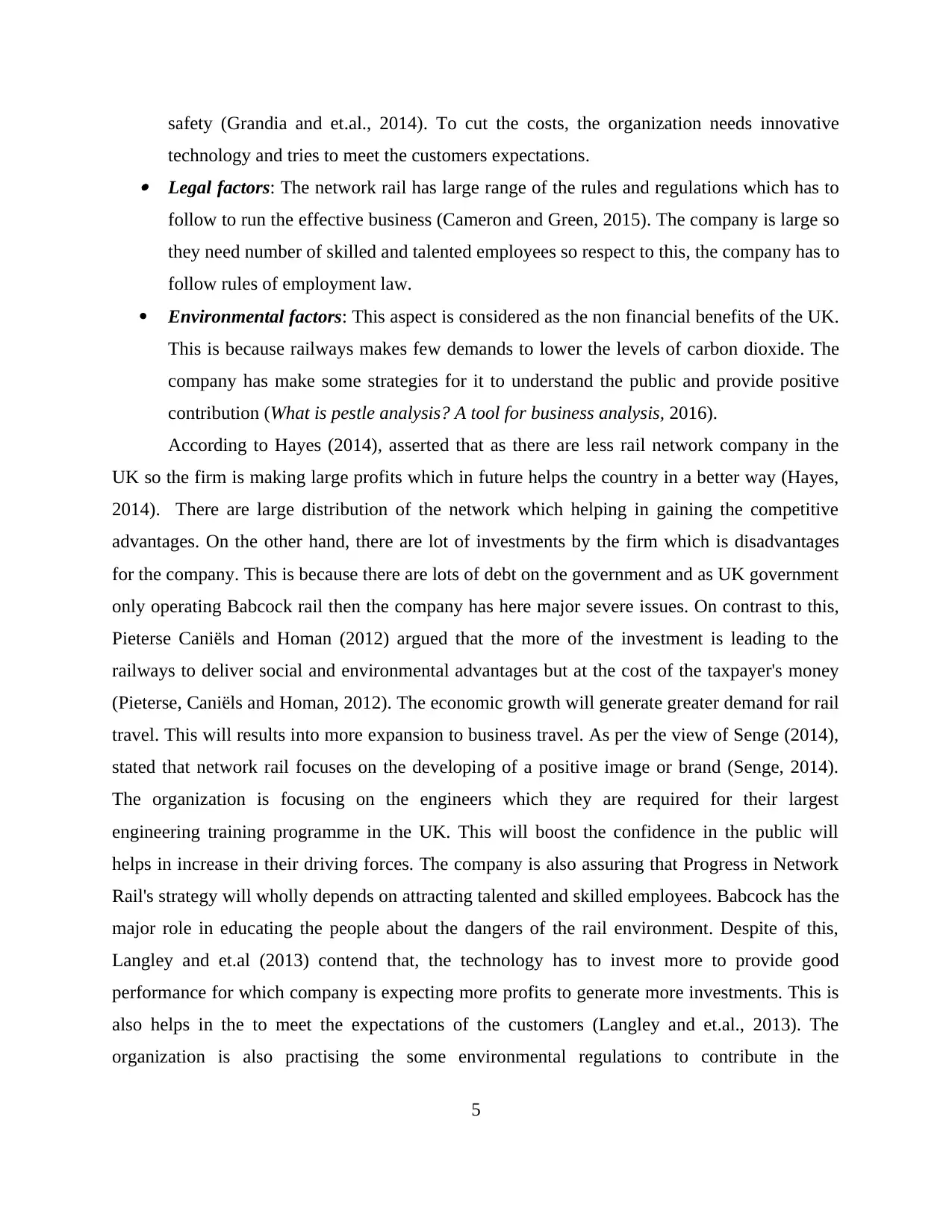
safety (Grandia and et.al., 2014). To cut the costs, the organization needs innovative
technology and tries to meet the customers expectations. Legal factors: The network rail has large range of the rules and regulations which has to
follow to run the effective business (Cameron and Green, 2015). The company is large so
they need number of skilled and talented employees so respect to this, the company has to
follow rules of employment law.
Environmental factors: This aspect is considered as the non financial benefits of the UK.
This is because railways makes few demands to lower the levels of carbon dioxide. The
company has make some strategies for it to understand the public and provide positive
contribution (What is pestle analysis? A tool for business analysis, 2016).
According to Hayes (2014), asserted that as there are less rail network company in the
UK so the firm is making large profits which in future helps the country in a better way (Hayes,
2014). There are large distribution of the network which helping in gaining the competitive
advantages. On the other hand, there are lot of investments by the firm which is disadvantages
for the company. This is because there are lots of debt on the government and as UK government
only operating Babcock rail then the company has here major severe issues. On contrast to this,
Pieterse Caniëls and Homan (2012) argued that the more of the investment is leading to the
railways to deliver social and environmental advantages but at the cost of the taxpayer's money
(Pieterse, Caniëls and Homan, 2012). The economic growth will generate greater demand for rail
travel. This will results into more expansion to business travel. As per the view of Senge (2014),
stated that network rail focuses on the developing of a positive image or brand (Senge, 2014).
The organization is focusing on the engineers which they are required for their largest
engineering training programme in the UK. This will boost the confidence in the public will
helps in increase in their driving forces. The company is also assuring that Progress in Network
Rail's strategy will wholly depends on attracting talented and skilled employees. Babcock has the
major role in educating the people about the dangers of the rail environment. Despite of this,
Langley and et.al (2013) contend that, the technology has to invest more to provide good
performance for which company is expecting more profits to generate more investments. This is
also helps in the to meet the expectations of the customers (Langley and et.al., 2013). The
organization is also practising the some environmental regulations to contribute in the
5
technology and tries to meet the customers expectations. Legal factors: The network rail has large range of the rules and regulations which has to
follow to run the effective business (Cameron and Green, 2015). The company is large so
they need number of skilled and talented employees so respect to this, the company has to
follow rules of employment law.
Environmental factors: This aspect is considered as the non financial benefits of the UK.
This is because railways makes few demands to lower the levels of carbon dioxide. The
company has make some strategies for it to understand the public and provide positive
contribution (What is pestle analysis? A tool for business analysis, 2016).
According to Hayes (2014), asserted that as there are less rail network company in the
UK so the firm is making large profits which in future helps the country in a better way (Hayes,
2014). There are large distribution of the network which helping in gaining the competitive
advantages. On the other hand, there are lot of investments by the firm which is disadvantages
for the company. This is because there are lots of debt on the government and as UK government
only operating Babcock rail then the company has here major severe issues. On contrast to this,
Pieterse Caniëls and Homan (2012) argued that the more of the investment is leading to the
railways to deliver social and environmental advantages but at the cost of the taxpayer's money
(Pieterse, Caniëls and Homan, 2012). The economic growth will generate greater demand for rail
travel. This will results into more expansion to business travel. As per the view of Senge (2014),
stated that network rail focuses on the developing of a positive image or brand (Senge, 2014).
The organization is focusing on the engineers which they are required for their largest
engineering training programme in the UK. This will boost the confidence in the public will
helps in increase in their driving forces. The company is also assuring that Progress in Network
Rail's strategy will wholly depends on attracting talented and skilled employees. Babcock has the
major role in educating the people about the dangers of the rail environment. Despite of this,
Langley and et.al (2013) contend that, the technology has to invest more to provide good
performance for which company is expecting more profits to generate more investments. This is
also helps in the to meet the expectations of the customers (Langley and et.al., 2013). The
organization is also practising the some environmental regulations to contribute in the
5
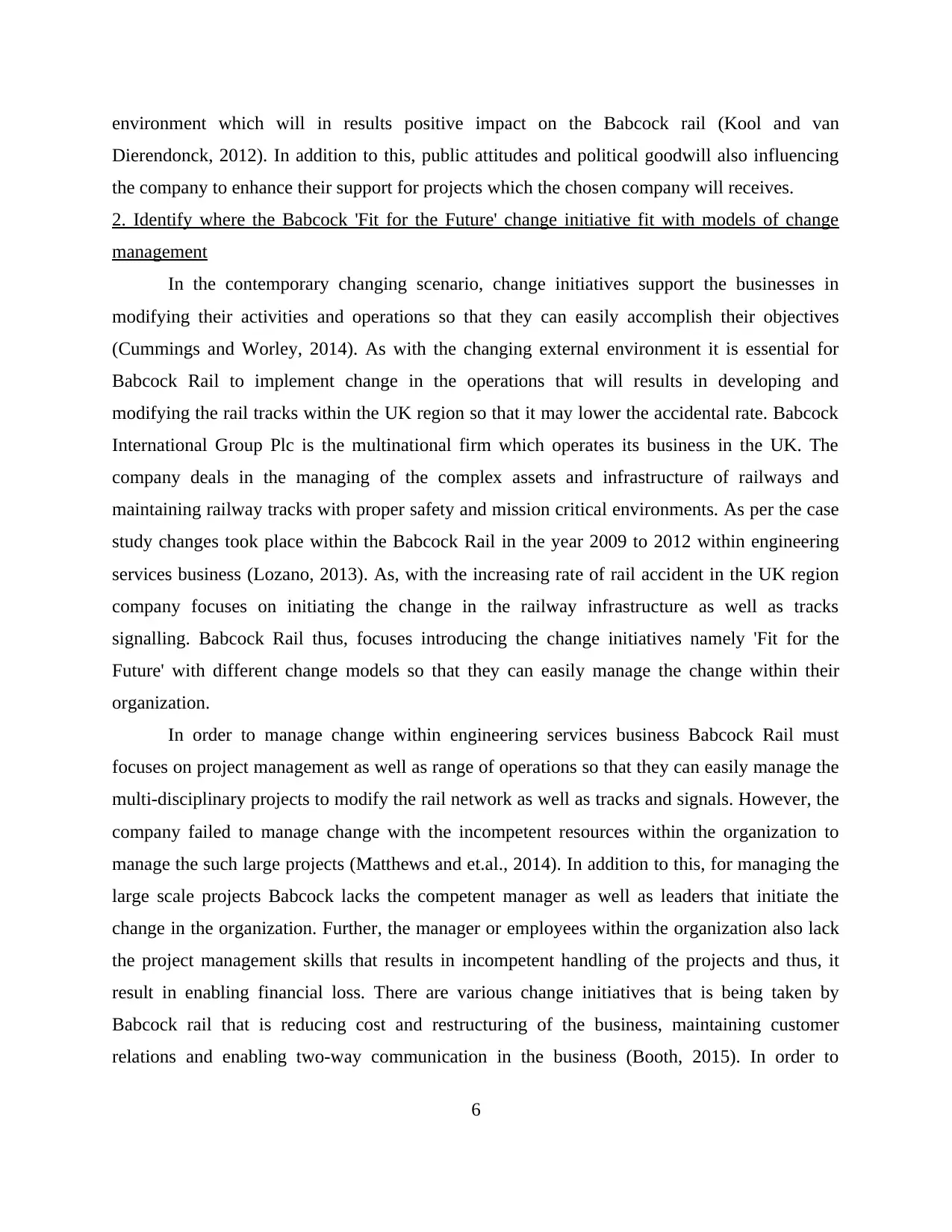
environment which will in results positive impact on the Babcock rail (Kool and van
Dierendonck, 2012). In addition to this, public attitudes and political goodwill also influencing
the company to enhance their support for projects which the chosen company will receives.
2. Identify where the Babcock 'Fit for the Future' change initiative fit with models of change
management
In the contemporary changing scenario, change initiatives support the businesses in
modifying their activities and operations so that they can easily accomplish their objectives
(Cummings and Worley, 2014). As with the changing external environment it is essential for
Babcock Rail to implement change in the operations that will results in developing and
modifying the rail tracks within the UK region so that it may lower the accidental rate. Babcock
International Group Plc is the multinational firm which operates its business in the UK. The
company deals in the managing of the complex assets and infrastructure of railways and
maintaining railway tracks with proper safety and mission critical environments. As per the case
study changes took place within the Babcock Rail in the year 2009 to 2012 within engineering
services business (Lozano, 2013). As, with the increasing rate of rail accident in the UK region
company focuses on initiating the change in the railway infrastructure as well as tracks
signalling. Babcock Rail thus, focuses introducing the change initiatives namely 'Fit for the
Future' with different change models so that they can easily manage the change within their
organization.
In order to manage change within engineering services business Babcock Rail must
focuses on project management as well as range of operations so that they can easily manage the
multi-disciplinary projects to modify the rail network as well as tracks and signals. However, the
company failed to manage change with the incompetent resources within the organization to
manage the such large projects (Matthews and et.al., 2014). In addition to this, for managing the
large scale projects Babcock lacks the competent manager as well as leaders that initiate the
change in the organization. Further, the manager or employees within the organization also lack
the project management skills that results in incompetent handling of the projects and thus, it
result in enabling financial loss. There are various change initiatives that is being taken by
Babcock rail that is reducing cost and restructuring of the business, maintaining customer
relations and enabling two-way communication in the business (Booth, 2015). In order to
6
Dierendonck, 2012). In addition to this, public attitudes and political goodwill also influencing
the company to enhance their support for projects which the chosen company will receives.
2. Identify where the Babcock 'Fit for the Future' change initiative fit with models of change
management
In the contemporary changing scenario, change initiatives support the businesses in
modifying their activities and operations so that they can easily accomplish their objectives
(Cummings and Worley, 2014). As with the changing external environment it is essential for
Babcock Rail to implement change in the operations that will results in developing and
modifying the rail tracks within the UK region so that it may lower the accidental rate. Babcock
International Group Plc is the multinational firm which operates its business in the UK. The
company deals in the managing of the complex assets and infrastructure of railways and
maintaining railway tracks with proper safety and mission critical environments. As per the case
study changes took place within the Babcock Rail in the year 2009 to 2012 within engineering
services business (Lozano, 2013). As, with the increasing rate of rail accident in the UK region
company focuses on initiating the change in the railway infrastructure as well as tracks
signalling. Babcock Rail thus, focuses introducing the change initiatives namely 'Fit for the
Future' with different change models so that they can easily manage the change within their
organization.
In order to manage change within engineering services business Babcock Rail must
focuses on project management as well as range of operations so that they can easily manage the
multi-disciplinary projects to modify the rail network as well as tracks and signals. However, the
company failed to manage change with the incompetent resources within the organization to
manage the such large projects (Matthews and et.al., 2014). In addition to this, for managing the
large scale projects Babcock lacks the competent manager as well as leaders that initiate the
change in the organization. Further, the manager or employees within the organization also lack
the project management skills that results in incompetent handling of the projects and thus, it
result in enabling financial loss. There are various change initiatives that is being taken by
Babcock rail that is reducing cost and restructuring of the business, maintaining customer
relations and enabling two-way communication in the business (Booth, 2015). In order to
6
⊘ This is a preview!⊘
Do you want full access?
Subscribe today to unlock all pages.

Trusted by 1+ million students worldwide
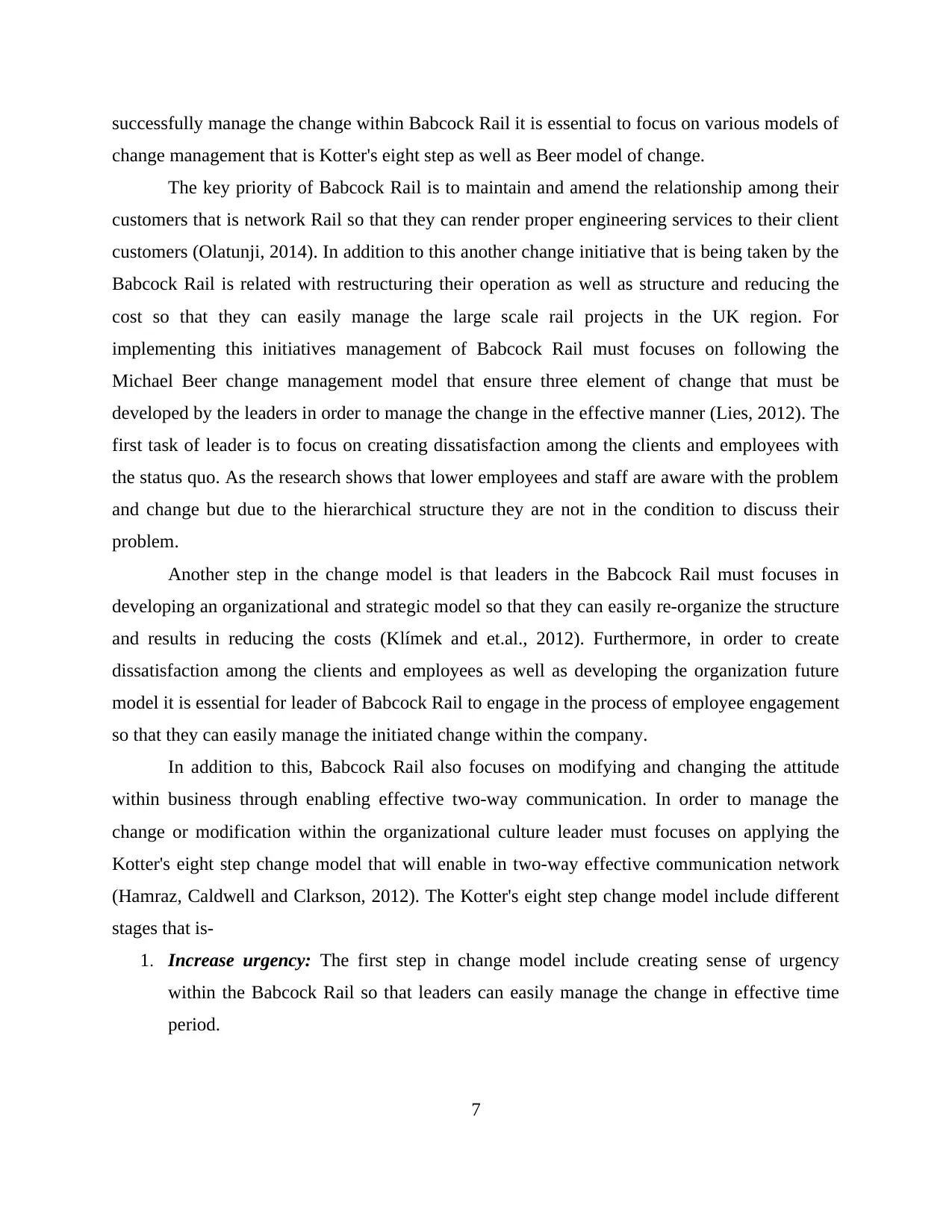
successfully manage the change within Babcock Rail it is essential to focus on various models of
change management that is Kotter's eight step as well as Beer model of change.
The key priority of Babcock Rail is to maintain and amend the relationship among their
customers that is network Rail so that they can render proper engineering services to their client
customers (Olatunji, 2014). In addition to this another change initiative that is being taken by the
Babcock Rail is related with restructuring their operation as well as structure and reducing the
cost so that they can easily manage the large scale rail projects in the UK region. For
implementing this initiatives management of Babcock Rail must focuses on following the
Michael Beer change management model that ensure three element of change that must be
developed by the leaders in order to manage the change in the effective manner (Lies, 2012). The
first task of leader is to focus on creating dissatisfaction among the clients and employees with
the status quo. As the research shows that lower employees and staff are aware with the problem
and change but due to the hierarchical structure they are not in the condition to discuss their
problem.
Another step in the change model is that leaders in the Babcock Rail must focuses in
developing an organizational and strategic model so that they can easily re-organize the structure
and results in reducing the costs (Klímek and et.al., 2012). Furthermore, in order to create
dissatisfaction among the clients and employees as well as developing the organization future
model it is essential for leader of Babcock Rail to engage in the process of employee engagement
so that they can easily manage the initiated change within the company.
In addition to this, Babcock Rail also focuses on modifying and changing the attitude
within business through enabling effective two-way communication. In order to manage the
change or modification within the organizational culture leader must focuses on applying the
Kotter's eight step change model that will enable in two-way effective communication network
(Hamraz, Caldwell and Clarkson, 2012). The Kotter's eight step change model include different
stages that is-
1. Increase urgency: The first step in change model include creating sense of urgency
within the Babcock Rail so that leaders can easily manage the change in effective time
period.
7
change management that is Kotter's eight step as well as Beer model of change.
The key priority of Babcock Rail is to maintain and amend the relationship among their
customers that is network Rail so that they can render proper engineering services to their client
customers (Olatunji, 2014). In addition to this another change initiative that is being taken by the
Babcock Rail is related with restructuring their operation as well as structure and reducing the
cost so that they can easily manage the large scale rail projects in the UK region. For
implementing this initiatives management of Babcock Rail must focuses on following the
Michael Beer change management model that ensure three element of change that must be
developed by the leaders in order to manage the change in the effective manner (Lies, 2012). The
first task of leader is to focus on creating dissatisfaction among the clients and employees with
the status quo. As the research shows that lower employees and staff are aware with the problem
and change but due to the hierarchical structure they are not in the condition to discuss their
problem.
Another step in the change model is that leaders in the Babcock Rail must focuses in
developing an organizational and strategic model so that they can easily re-organize the structure
and results in reducing the costs (Klímek and et.al., 2012). Furthermore, in order to create
dissatisfaction among the clients and employees as well as developing the organization future
model it is essential for leader of Babcock Rail to engage in the process of employee engagement
so that they can easily manage the initiated change within the company.
In addition to this, Babcock Rail also focuses on modifying and changing the attitude
within business through enabling effective two-way communication. In order to manage the
change or modification within the organizational culture leader must focuses on applying the
Kotter's eight step change model that will enable in two-way effective communication network
(Hamraz, Caldwell and Clarkson, 2012). The Kotter's eight step change model include different
stages that is-
1. Increase urgency: The first step in change model include creating sense of urgency
within the Babcock Rail so that leaders can easily manage the change in effective time
period.
7
Paraphrase This Document
Need a fresh take? Get an instant paraphrase of this document with our AI Paraphraser
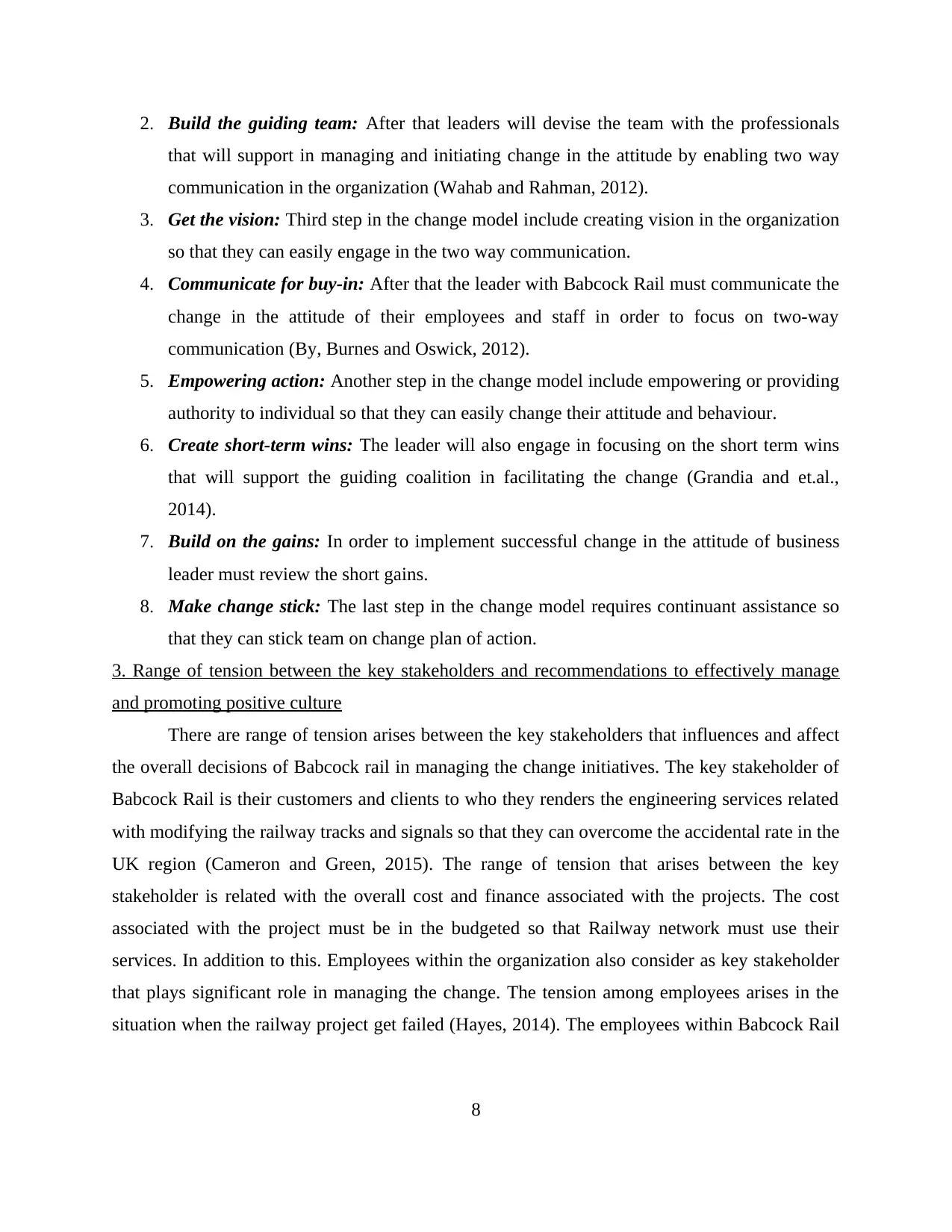
2. Build the guiding team: After that leaders will devise the team with the professionals
that will support in managing and initiating change in the attitude by enabling two way
communication in the organization (Wahab and Rahman, 2012).
3. Get the vision: Third step in the change model include creating vision in the organization
so that they can easily engage in the two way communication.
4. Communicate for buy-in: After that the leader with Babcock Rail must communicate the
change in the attitude of their employees and staff in order to focus on two-way
communication (By, Burnes and Oswick, 2012).
5. Empowering action: Another step in the change model include empowering or providing
authority to individual so that they can easily change their attitude and behaviour.
6. Create short-term wins: The leader will also engage in focusing on the short term wins
that will support the guiding coalition in facilitating the change (Grandia and et.al.,
2014).
7. Build on the gains: In order to implement successful change in the attitude of business
leader must review the short gains.
8. Make change stick: The last step in the change model requires continuant assistance so
that they can stick team on change plan of action.
3. Range of tension between the key stakeholders and recommendations to effectively manage
and promoting positive culture
There are range of tension arises between the key stakeholders that influences and affect
the overall decisions of Babcock rail in managing the change initiatives. The key stakeholder of
Babcock Rail is their customers and clients to who they renders the engineering services related
with modifying the railway tracks and signals so that they can overcome the accidental rate in the
UK region (Cameron and Green, 2015). The range of tension that arises between the key
stakeholder is related with the overall cost and finance associated with the projects. The cost
associated with the project must be in the budgeted so that Railway network must use their
services. In addition to this. Employees within the organization also consider as key stakeholder
that plays significant role in managing the change. The tension among employees arises in the
situation when the railway project get failed (Hayes, 2014). The employees within Babcock Rail
8
that will support in managing and initiating change in the attitude by enabling two way
communication in the organization (Wahab and Rahman, 2012).
3. Get the vision: Third step in the change model include creating vision in the organization
so that they can easily engage in the two way communication.
4. Communicate for buy-in: After that the leader with Babcock Rail must communicate the
change in the attitude of their employees and staff in order to focus on two-way
communication (By, Burnes and Oswick, 2012).
5. Empowering action: Another step in the change model include empowering or providing
authority to individual so that they can easily change their attitude and behaviour.
6. Create short-term wins: The leader will also engage in focusing on the short term wins
that will support the guiding coalition in facilitating the change (Grandia and et.al.,
2014).
7. Build on the gains: In order to implement successful change in the attitude of business
leader must review the short gains.
8. Make change stick: The last step in the change model requires continuant assistance so
that they can stick team on change plan of action.
3. Range of tension between the key stakeholders and recommendations to effectively manage
and promoting positive culture
There are range of tension arises between the key stakeholders that influences and affect
the overall decisions of Babcock rail in managing the change initiatives. The key stakeholder of
Babcock Rail is their customers and clients to who they renders the engineering services related
with modifying the railway tracks and signals so that they can overcome the accidental rate in the
UK region (Cameron and Green, 2015). The range of tension that arises between the key
stakeholder is related with the overall cost and finance associated with the projects. The cost
associated with the project must be in the budgeted so that Railway network must use their
services. In addition to this. Employees within the organization also consider as key stakeholder
that plays significant role in managing the change. The tension among employees arises in the
situation when the railway project get failed (Hayes, 2014). The employees within Babcock Rail
8
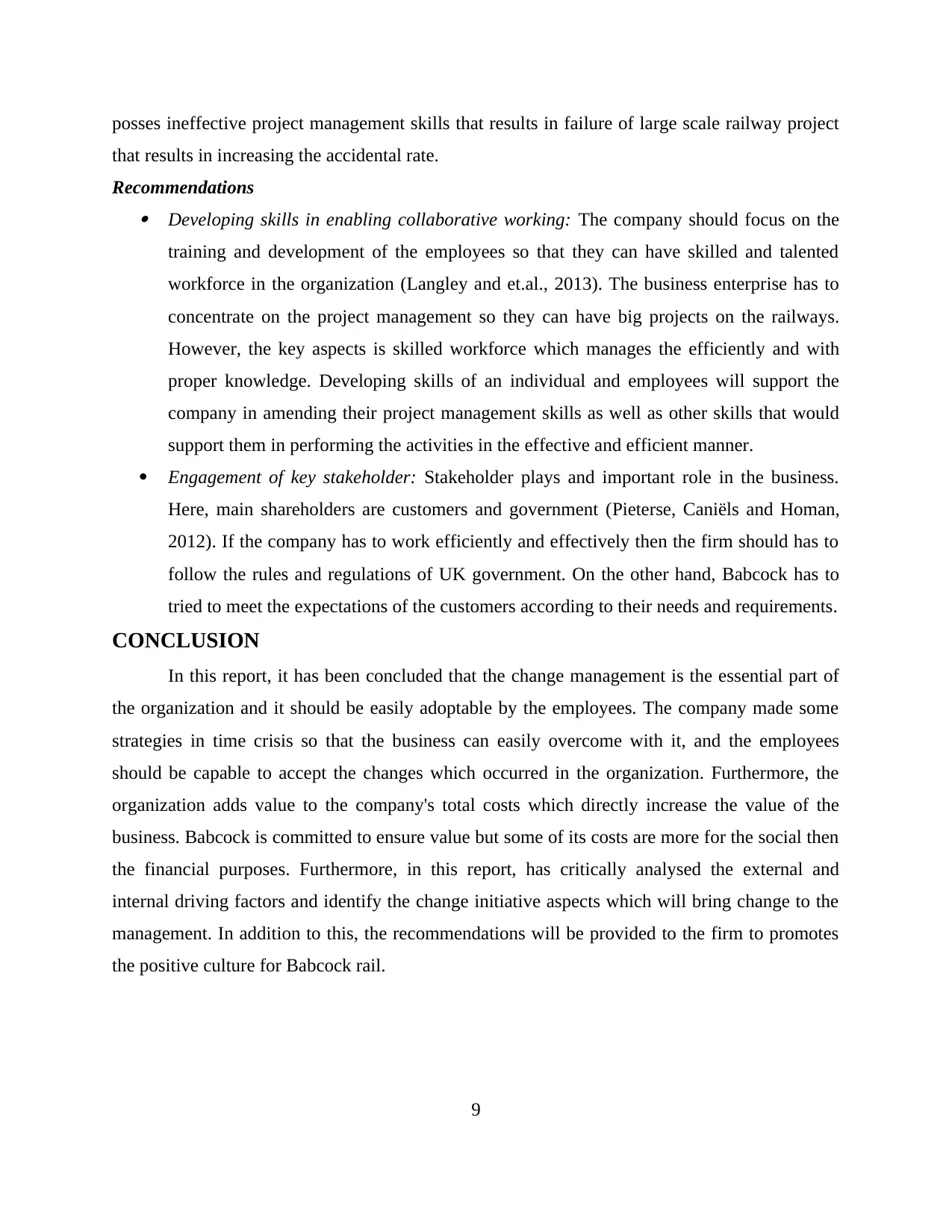
posses ineffective project management skills that results in failure of large scale railway project
that results in increasing the accidental rate.
Recommendations Developing skills in enabling collaborative working: The company should focus on the
training and development of the employees so that they can have skilled and talented
workforce in the organization (Langley and et.al., 2013). The business enterprise has to
concentrate on the project management so they can have big projects on the railways.
However, the key aspects is skilled workforce which manages the efficiently and with
proper knowledge. Developing skills of an individual and employees will support the
company in amending their project management skills as well as other skills that would
support them in performing the activities in the effective and efficient manner.
Engagement of key stakeholder: Stakeholder plays and important role in the business.
Here, main shareholders are customers and government (Pieterse, Caniëls and Homan,
2012). If the company has to work efficiently and effectively then the firm should has to
follow the rules and regulations of UK government. On the other hand, Babcock has to
tried to meet the expectations of the customers according to their needs and requirements.
CONCLUSION
In this report, it has been concluded that the change management is the essential part of
the organization and it should be easily adoptable by the employees. The company made some
strategies in time crisis so that the business can easily overcome with it, and the employees
should be capable to accept the changes which occurred in the organization. Furthermore, the
organization adds value to the company's total costs which directly increase the value of the
business. Babcock is committed to ensure value but some of its costs are more for the social then
the financial purposes. Furthermore, in this report, has critically analysed the external and
internal driving factors and identify the change initiative aspects which will bring change to the
management. In addition to this, the recommendations will be provided to the firm to promotes
the positive culture for Babcock rail.
9
that results in increasing the accidental rate.
Recommendations Developing skills in enabling collaborative working: The company should focus on the
training and development of the employees so that they can have skilled and talented
workforce in the organization (Langley and et.al., 2013). The business enterprise has to
concentrate on the project management so they can have big projects on the railways.
However, the key aspects is skilled workforce which manages the efficiently and with
proper knowledge. Developing skills of an individual and employees will support the
company in amending their project management skills as well as other skills that would
support them in performing the activities in the effective and efficient manner.
Engagement of key stakeholder: Stakeholder plays and important role in the business.
Here, main shareholders are customers and government (Pieterse, Caniëls and Homan,
2012). If the company has to work efficiently and effectively then the firm should has to
follow the rules and regulations of UK government. On the other hand, Babcock has to
tried to meet the expectations of the customers according to their needs and requirements.
CONCLUSION
In this report, it has been concluded that the change management is the essential part of
the organization and it should be easily adoptable by the employees. The company made some
strategies in time crisis so that the business can easily overcome with it, and the employees
should be capable to accept the changes which occurred in the organization. Furthermore, the
organization adds value to the company's total costs which directly increase the value of the
business. Babcock is committed to ensure value but some of its costs are more for the social then
the financial purposes. Furthermore, in this report, has critically analysed the external and
internal driving factors and identify the change initiative aspects which will bring change to the
management. In addition to this, the recommendations will be provided to the firm to promotes
the positive culture for Babcock rail.
9
⊘ This is a preview!⊘
Do you want full access?
Subscribe today to unlock all pages.

Trusted by 1+ million students worldwide
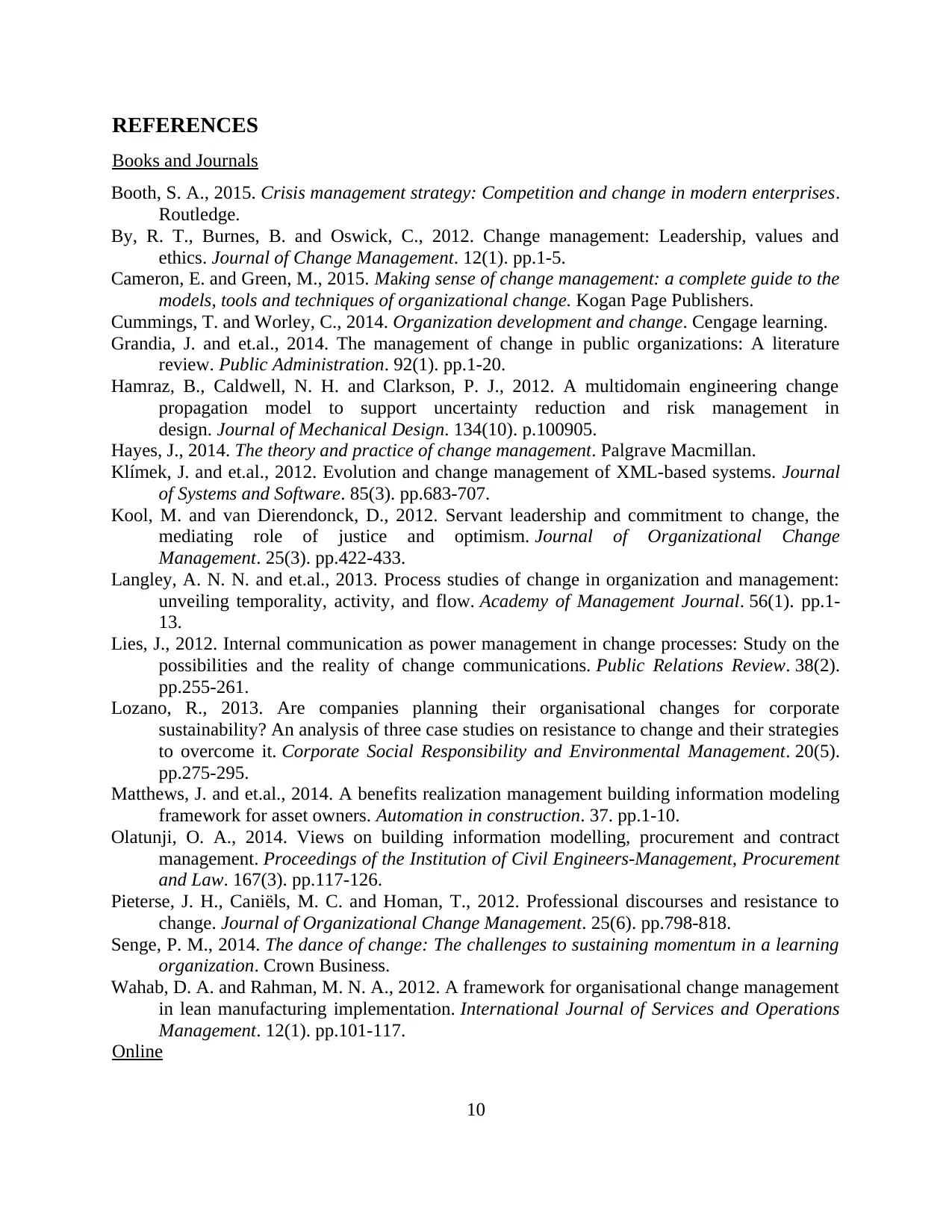
REFERENCES
Books and Journals
Booth, S. A., 2015. Crisis management strategy: Competition and change in modern enterprises.
Routledge.
By, R. T., Burnes, B. and Oswick, C., 2012. Change management: Leadership, values and
ethics. Journal of Change Management. 12(1). pp.1-5.
Cameron, E. and Green, M., 2015. Making sense of change management: a complete guide to the
models, tools and techniques of organizational change. Kogan Page Publishers.
Cummings, T. and Worley, C., 2014. Organization development and change. Cengage learning.
Grandia, J. and et.al., 2014. The management of change in public organizations: A literature
review. Public Administration. 92(1). pp.1-20.
Hamraz, B., Caldwell, N. H. and Clarkson, P. J., 2012. A multidomain engineering change
propagation model to support uncertainty reduction and risk management in
design. Journal of Mechanical Design. 134(10). p.100905.
Hayes, J., 2014. The theory and practice of change management. Palgrave Macmillan.
Klímek, J. and et.al., 2012. Evolution and change management of XML-based systems. Journal
of Systems and Software. 85(3). pp.683-707.
Kool, M. and van Dierendonck, D., 2012. Servant leadership and commitment to change, the
mediating role of justice and optimism. Journal of Organizational Change
Management. 25(3). pp.422-433.
Langley, A. N. N. and et.al., 2013. Process studies of change in organization and management:
unveiling temporality, activity, and flow. Academy of Management Journal. 56(1). pp.1-
13.
Lies, J., 2012. Internal communication as power management in change processes: Study on the
possibilities and the reality of change communications. Public Relations Review. 38(2).
pp.255-261.
Lozano, R., 2013. Are companies planning their organisational changes for corporate
sustainability? An analysis of three case studies on resistance to change and their strategies
to overcome it. Corporate Social Responsibility and Environmental Management. 20(5).
pp.275-295.
Matthews, J. and et.al., 2014. A benefits realization management building information modeling
framework for asset owners. Automation in construction. 37. pp.1-10.
Olatunji, O. A., 2014. Views on building information modelling, procurement and contract
management. Proceedings of the Institution of Civil Engineers-Management, Procurement
and Law. 167(3). pp.117-126.
Pieterse, J. H., Caniëls, M. C. and Homan, T., 2012. Professional discourses and resistance to
change. Journal of Organizational Change Management. 25(6). pp.798-818.
Senge, P. M., 2014. The dance of change: The challenges to sustaining momentum in a learning
organization. Crown Business.
Wahab, D. A. and Rahman, M. N. A., 2012. A framework for organisational change management
in lean manufacturing implementation. International Journal of Services and Operations
Management. 12(1). pp.101-117.
Online
10
Books and Journals
Booth, S. A., 2015. Crisis management strategy: Competition and change in modern enterprises.
Routledge.
By, R. T., Burnes, B. and Oswick, C., 2012. Change management: Leadership, values and
ethics. Journal of Change Management. 12(1). pp.1-5.
Cameron, E. and Green, M., 2015. Making sense of change management: a complete guide to the
models, tools and techniques of organizational change. Kogan Page Publishers.
Cummings, T. and Worley, C., 2014. Organization development and change. Cengage learning.
Grandia, J. and et.al., 2014. The management of change in public organizations: A literature
review. Public Administration. 92(1). pp.1-20.
Hamraz, B., Caldwell, N. H. and Clarkson, P. J., 2012. A multidomain engineering change
propagation model to support uncertainty reduction and risk management in
design. Journal of Mechanical Design. 134(10). p.100905.
Hayes, J., 2014. The theory and practice of change management. Palgrave Macmillan.
Klímek, J. and et.al., 2012. Evolution and change management of XML-based systems. Journal
of Systems and Software. 85(3). pp.683-707.
Kool, M. and van Dierendonck, D., 2012. Servant leadership and commitment to change, the
mediating role of justice and optimism. Journal of Organizational Change
Management. 25(3). pp.422-433.
Langley, A. N. N. and et.al., 2013. Process studies of change in organization and management:
unveiling temporality, activity, and flow. Academy of Management Journal. 56(1). pp.1-
13.
Lies, J., 2012. Internal communication as power management in change processes: Study on the
possibilities and the reality of change communications. Public Relations Review. 38(2).
pp.255-261.
Lozano, R., 2013. Are companies planning their organisational changes for corporate
sustainability? An analysis of three case studies on resistance to change and their strategies
to overcome it. Corporate Social Responsibility and Environmental Management. 20(5).
pp.275-295.
Matthews, J. and et.al., 2014. A benefits realization management building information modeling
framework for asset owners. Automation in construction. 37. pp.1-10.
Olatunji, O. A., 2014. Views on building information modelling, procurement and contract
management. Proceedings of the Institution of Civil Engineers-Management, Procurement
and Law. 167(3). pp.117-126.
Pieterse, J. H., Caniëls, M. C. and Homan, T., 2012. Professional discourses and resistance to
change. Journal of Organizational Change Management. 25(6). pp.798-818.
Senge, P. M., 2014. The dance of change: The challenges to sustaining momentum in a learning
organization. Crown Business.
Wahab, D. A. and Rahman, M. N. A., 2012. A framework for organisational change management
in lean manufacturing implementation. International Journal of Services and Operations
Management. 12(1). pp.101-117.
Online
10
Paraphrase This Document
Need a fresh take? Get an instant paraphrase of this document with our AI Paraphraser

Babcock Internattional. 2016. [Online]. Available through:
<https://www.babcockinternational.com/Sectors/Rail>. [Accessed on 26th April 2016].
What is pestle analysis? A tool for business analysis. 2016. [Online]. Available through:
<http://pestleanalysis.com/what-is-pestle-analysis/>. [Accessed on 26th April 2016].
11
<https://www.babcockinternational.com/Sectors/Rail>. [Accessed on 26th April 2016].
What is pestle analysis? A tool for business analysis. 2016. [Online]. Available through:
<http://pestleanalysis.com/what-is-pestle-analysis/>. [Accessed on 26th April 2016].
11
1 out of 11
Related Documents
Your All-in-One AI-Powered Toolkit for Academic Success.
+13062052269
info@desklib.com
Available 24*7 on WhatsApp / Email
![[object Object]](/_next/static/media/star-bottom.7253800d.svg)
Unlock your academic potential
Copyright © 2020–2025 A2Z Services. All Rights Reserved. Developed and managed by ZUCOL.





